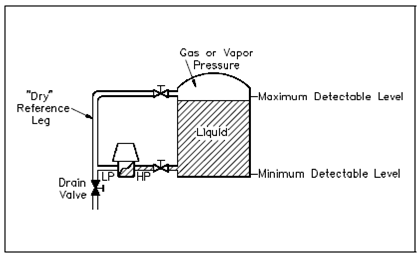Close Tank Differential Pressure Detector:
Not all tanks or vessels are open to the atmosphere. Several are totally enclosed to avoid vapors or steam from escaping, or to permit pressurizing the contents of the tank. While measuring the level in a tank which is pressurized or the level which could become pressurized through vapor pressure from the liquid, the high pressure and low pressure sides both of the ?P transmitters must be linked show in the Figure.

Figure: Closed Tank, Dry Reference Leg
The high pressure connection is connected to the tank at or below the lower range value to be measured. The low pressure side is also linked to a "reference leg" which is connected at or above the upper range value to be measured. The reference leg is pressurized through the gas or vapor pressure, but no liquid is allowed to remain in the reference leg. A reference leg has to be managed dry so that there is no liquid head pressure on the low pressure side of the transmitter. A high pressure side is exposed to the hydrostatic head of the liquid plus the gas or vapor pressure exerted on to the liquid's surface. The gas or vapor pressure is evenly applied to the low and high pressure sides. Thus, the outcome of the ?P transmitter is directly proportional to the hydrostatic head pressure, which is, the level in the tank.